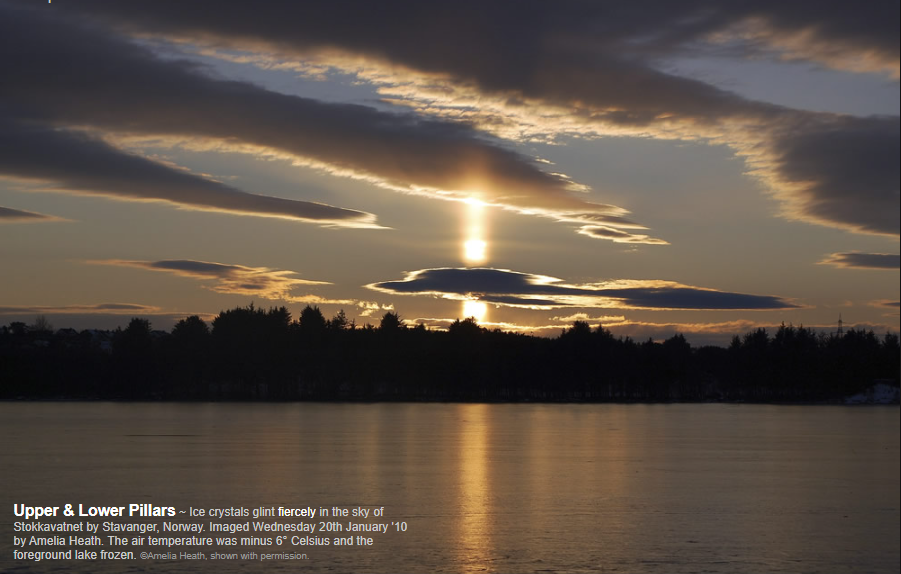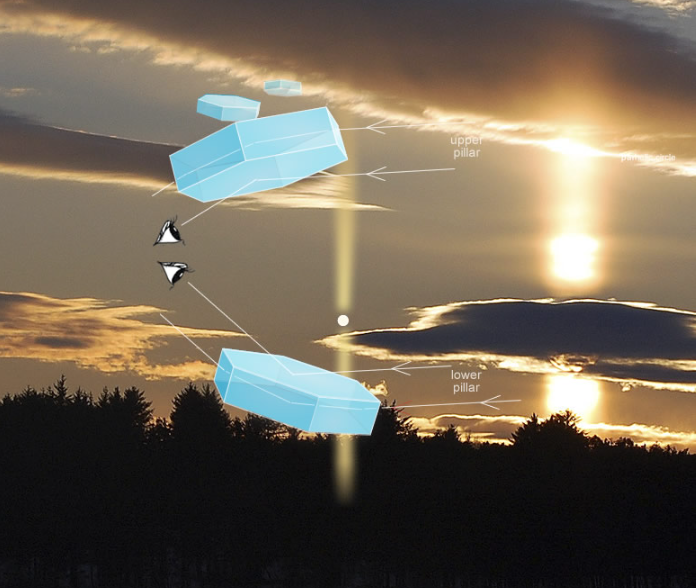Two pillars
Two Pillars: Exploring the Phenomenon of Sun Pillars
Sun pillars, also known as light pillars, are a captivating atmospheric optical phenomenon that can be observed in certain weather conditions. These vertical columns of light appear to extend upwards or downwards from the Sun, creating a mesmerizing sight in the sky. In this article, we will delve deeper into the intricacies of sun pillars and explore the factors that contribute to their formation.
Understanding Sun Pillars
-
Plate-like Crystals: Most sun pillars are formed by plate-like ice crystals suspended in the atmosphere. These crystals can take on various shapes, including wobbly semi-snowflake varieties. Unlike other atmospheric halos, sun pillars often stand alone in the sky due to crystal faults that prevent the formation of additional arcs.
-
Upper Pillars: Rays of sunlight reflected downwards from the lower faces of tilted crystals contribute to the formation of upper pillars. In high-quality plate crystals, a significant number of these rays enter a side face, undergo total internal reflection multiple times, and exit through the opposite side face. The refraction at these two faces is equal, resulting in colorless pillars. However, the incident sunlight's color can be reflected, leading to highly reddened upper pillars.
-
Lower Pillars: On the other hand, lower pillars form when sunlight is reflected upwards from the topmost crystal face. These pillars also exhibit the color of the incident sunlight and contribute to the overall spectacle.
The Role of Crystal Alignment and Tilt
-
Crystal Alignment: While most atmospheric halos are at their finest when ice crystals are well aligned, sun pillars require crystals with larger tilts. In fact, the greater the tilt of the crystals, the taller the resulting pillar becomes. This unique characteristic sets sun pillars apart from other atmospheric optical phenomena.
-
Weather Conditions: The formation of sun pillars is influenced by specific weather conditions. Cold temperatures, typically below freezing, are essential for the creation of ice crystals in the atmosphere. Additionally, the presence of high-altitude clouds, such as cirrus clouds, is often associated with the occurrence of sun pillars.
Observing and Photographing Sun Pillars
-
Ideal Locations: Sun pillars can be observed in various locations worldwide, particularly in regions with cold climates. Places like northern latitudes, where freezing temperatures are more common, offer frequent opportunities to witness this captivating atmospheric display.
-
Optimal Viewing Times: Sun pillars are most commonly observed during sunrise or sunset when the Sun is low on the horizon. The angle of the sunlight interacting with the ice crystals is crucial for the formation and visibility of the pillars.
-
Photographing Sun Pillars: Capturing the beauty of sun pillars through photography can be a rewarding experience. To enhance your chances of capturing stunning images, consider these tips:
- Use a tripod to stabilize your camera and prevent blurriness.
- Adjust your camera settings to optimize exposure and capture the details of the pillar.
- Experiment with different angles and compositions to add depth and interest to your photographs.
- Utilize foreground elements, such as trees or buildings, to provide context and scale to your images.
The Magic of Sun Pillars
-
Educational Value: Sun pillars not only captivate our eyes but also serve as a valuable educational tool. Studying these atmospheric phenomena helps scientists and meteorologists better understand the intricacies of light scattering, crystal formation, and atmospheric conditions.
-
Appreciating Nature's Wonders: Sun pillars remind us of the beauty and complexity present in our natural world. By taking the time to observe and appreciate these mesmerizing displays, we can cultivate a deeper connection with our environment and gain a greater appreciation for the wonders that surround us.
In conclusion, sun pillars are a fascinating atmospheric optical phenomenon that adds a touch of magic to our skies. Understanding their formation, observing them in the right conditions, and capturing their beauty through photography allows us to appreciate the intricate wonders of our natural world. So, next time you find yourself in a cold climate during sunrise or sunset, keep an eye out for the enchanting sight of sun pillars dancing in the sky.

Upper & Lower Pillars ~ Ice crystals glint fiercely in the sky of Stokkavatnet by Stavanger, Norway. Imaged Wednesday 20th January '10 by Amelia Heath. The air temperature was minus 6° Celsius and the foreground lake frozen. ©Amelia Heath, shown with permission.

Most sun pillars are formed by plate-like crystals.
The plates can be wobbly semi-snowflake varieties. Optical perfection is unnecessary. Often pillars are the only halo in the sky because crystal faults like side faces blocked by growths or internal defects prevent other arcs from forming.
Upper pillars are created by rays reflected downwards from the lower faces of tilted crystals. In plate crystals of good quality, a significant number of pillar forming rays enter a side face, undergo total internal reflection an odd number of times from the upper and lower basal faces and then leave through the opposite side face. The refraction at the two faces is equal and so the pillar is not coloured. However, pillars adopt the colours of the incident sunlight which may be highly reddened.
Lower pillars form when light is reflected upwards from the topmost crystal face.
Most halos are at their finest when crystals are well aligned. In contrast, sun pillars need crystals with large tilts. The larger the tilts the taller is the pillar.
Note: this article has been automatically converted from the old site and may not appear as intended. You can find the original article here.
Reference Atmospheric Optics
If you use any of the definitions, information, or data presented on Atmospheric Optics, please copy the link or reference below to properly credit us as the reference source. Thank you!
-
<a href="https://atoptics.co.uk/blog/two-pillars/">Two pillars</a>
-
"Two pillars". Atmospheric Optics. Accessed on December 26, 2024. https://atoptics.co.uk/blog/two-pillars/.
-
"Two pillars". Atmospheric Optics, https://atoptics.co.uk/blog/two-pillars/. Accessed 26 December, 2024
-
Two pillars. Atmospheric Optics. Retrieved from https://atoptics.co.uk/blog/two-pillars/.